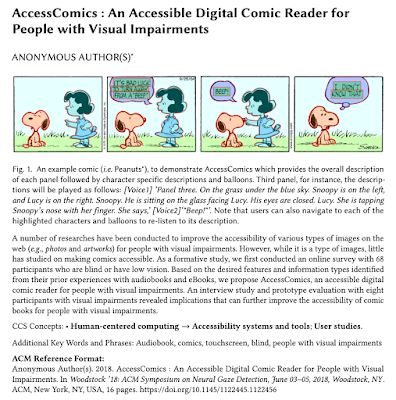Web4All 2021 - Accessibility and Crisis: AccessComics : An Accessible Digital Comic Reader for People with Visual Impairments (Accepted!)
I have been involved in research of creating a web application for visually impaired people to access comics.
The main technology used is computer vision technology to automatically segment recognize the elements of comics (Panel, Balloon, Text) and TTS technology to customize reading content.
I participated in the overall research process, but my main task was "user analysis". I made out and deployed a survey to find user requirements, participated in user study interviews evaluating usability, and was in charge of analyzing SUS results.
---------------------------------------------------------------------------------------
We set the following research questions with the goal of making comics accessible for PVI:
• RQ1. What are the accessibility issues that PVI face when reading comics?
• RQ2. How do PVI access audiobooks and eBooks in general? What are the desired features?
• RQ3.To what extend,canvariousattributesofaudiobooksandeBooksbeappliedfordesigning
an accessible comic reader for PVI?
To answer these questions, we first conducted an online survey with 68 participants who are blind or have low vision. By collecting their prior experiences with audiobooks and eBooks for accessing typical books, we designed and implemented AccessComics, an accessible digital comic reader for PVI, which a web application that can be accessed with a screen reader with various synthesized voices assigned for different characters. Then we conducted an in-depth interview and prototype evaluation with eight participants with visual impairments. As a result, we gained a deeper understanding of the types of information that PVI wish to receive when reading comics and the desired features of an accessible digital comic reader such as providing background sounds for an immersive experience, having voices with high variance of the pitch to be focused, and supporting speed reading for efficiency, which is ideal for synthesized voices. Based on the findings, we suggest implications for designing an accessible comic reader that can automate the process of making more number of digital comics more accessible and immersive to people with visual impairments.
The contributions of our study are as follows: (1) identifying accessibility issues of comics for PVI, (2) proposing and evaluating a prototype for improving the accessibility of comics, and (3) providing design suggestions for making comics accessible at a scale.

Comments
Post a Comment